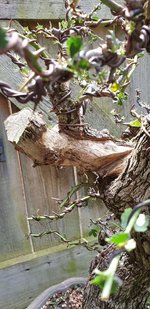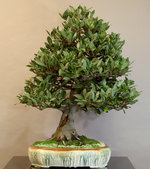Ya'all are over thinking it. Bonsai is an art. There are no rules in art. Sure, one can spout "guidelines", which are used when inspiration is lacking. Forget the rules. If the deadwood looks good, use it in your design. Even back in the 1960's Mary Madison and others were collecting Florida buttonwood with incredible old deadwood. In fact, the leaves on buttonwood are large, and they do not reduce much. Without deadwood, there is little reason to grow buttonwood. Deadwood on deciduous has been a well accepted fact since 1960's, and any whiners who think it isn't just have not looked at old show photos. They have forgotten bonsai history.
This whole discussion of "whether or not deadwood is allowed on broadleaf trees" is a dead issue, the question was answered back in the 1960's or even earlier.
If the deadwood is natural or created, as long as it "looks good" and can be incorporated into the design no problem. Use it. Broadleaf or deciduous, it doesn't matter. Key is whether it makes artistic sense. Of course there is natural nature made deadwood, there is man made deadwood, and there are trees with a mix of both. If it looks good, it does not matter.
If you start with 100 bonsai beginners, more than half the people in that group will have dropped out by the 5 year mark. Maybe 25% of the group stick with bonsai for more than 10 years, it is a rare few that make the 20 year mark and even less that make it longer. Only a very small percentage of the trees started by these people will actually get passed on to others and and exceed 25 years in cultivation. It hardly matters whether deadwood lasts longer than 20 years or not, most of the trees created won't make the 20 year mark.
Now for the rare tree that does survive more than 20 year in cultivation. There are many wood products that can help the deadwood to "hang around longer" so as to avoid the need for a "redesign" yet. I believe Mr Francois Jeker of France wrote a book on creating and preserving deadwood that goes beyond just the use of lime-sulfur. If you are willing to travel to Milwaukee Wisconsin for the June 23 thru June 26, 2022, the Milwaukee Bonsai Society is celebrating its 50th year by hosting Mr Jeker and the 2022 MABA convention. I believe there are still openings for the Francois Jeker workshops. This event was postponed from 2020, due to Covid. Francois Jeker agreed to the 2022 dates. The Milwaukee Bonsai Society website has not changed all the dates from 2020 to 2022, so don't let the mixed up years confuse you, it will happen in 2022.
I know from my house painting father, and have tried it, and it works, painting the deadwood with a coat or two of boiled linseed oil once a year will help keep old deadwood from drying out and decaying easily. The linseed oil will make the deadwood somewhat waterproof. It is a natural product, distilled from flax seed. Linseed oil is the base for Thompson's Waterseal, without the pigments and the higher price.
A similar product is to dissolve pinion pine resin in turpentine and paint it on like linseed oil. There are a number of other do it yourself ways to make deadwood waterproof, which will allow it to last MANY years longer than it would in normal conditions. These treatments will work on broadleaf deadwood just as effectively as on conifer deadwood.
So pick up the books by Francois Jeker, and come see him in Milwaukee in 2022. Deadwood can be used on any species, where ever it makes artistic sense. This is not a complicated question. It is "allowed", as there are no rules, it is art. And there are many tricks for making deadwood last longer that go beyond the use of lime-sulfur. There wood preservative, wood restorers and wood hardeners. Furniture shops are full of these products.
By the way, Superglue, the acryl cyanates are terrible for "hardening wood". They have a tendency to fog and become milky white a few years after application. There are better products. Read F. Jeker and others to find out.
 2018-11-30_03-45-47 by Bobby Lane, on Flickr
2018-11-30_03-45-47 by Bobby Lane, on Flickr 2018-11-30_03-45-47 by Bobby Lane, on Flickr
2018-11-30_03-45-47 by Bobby Lane, on Flickr







